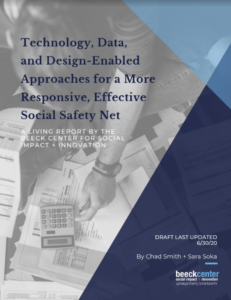Economic Recovery Starts with a Modern Social Safety Net Benefit System
July 24, 2020 – By Sara Soka + Chad Smith
“Build back better” is a phrase borrowed from disaster recovery. At its core it means when a system is damaged (or exposed as being damaged), the optimal repair uses all available resources to build back a stronger, more effective, and more resilient system.
Federal social safety net programs provide basic economic, food, and housing support to millions of Americans, but their eligibility, enrollment, and delivery processes are notoriously difficult to navigate. As demand for benefits grew with the economic impact of the COVID-19 pandemic, the insufficient capacity and burdensome processes of the social safety net became painfully apparent and widely publicized, though these conditions are not new. At the Beeck Center, we have been researching the leading-edge examples where data, design practices, and technology are being leveraged to more effectively deliver benefits. This ongoing research effort is showing what is possible and where governments, companies, and service-providing nonprofits are leaning into novel and ambitious approaches to help more people, faster, and for less cost.
Earlier this month, House Budget Committee Chairman John Yarmuth led a Congressional hearing about the longstanding need for federal investment in modernizing state and federal IT systems, made more urgent in the wake of COVID-19. “State unemployment offices, already underfunded and understaffed, were left completely unprepared for the massive influx of need,” Rep. Yarmuth said. “The federal government has long sought to prioritize modern, secure, and shared IT solutions, but funding uncertainties, stemming from constrained discretionary funding under budget caps, shutdown threats, and continuing resolutions have made agencies more likely to update instead of modernize.”

To support the ability of agencies to modernize at scale, our research details successful models for bringing social safety net benefit delivery up to contemporary standards. This living report — which we will update at regular intervals throughout 2020 — examines the data, design, technology, and innovation-enabled approaches that make it easier for eligible people to enroll in, and receive, federally-funded social safety net benefits.
Through our research, we seek to understand what tools and processes exist, which can be replicated, and what experts identify as overarching needs. We will present what new approaches are possible and can be replicated and scaled, especially if there is the political and popular will to drive a large federal investment in a tech-enabled social safety net in the wake of COVID-19. We anticipate that this living report will be of particular interest to leaders able to take integrated, system-wide action, including government executives, policymakers, and philanthropic organizations. We also hope it promotes aligned efforts between the nonprofits, public benefit corporations, and government agencies that are changing benefit delivery for the better.
“We cannot afford to pour time, attention, and enormous sums of money into a process for building and buying software that hasn’t worked for decades.”
– Jennifer Pahlka, U.S. Digital Response
Jennifer Pahlka, founder of Code for America and co-founder of the U.S. Digital Service and U.S. Digital Response testified before the House Budget Committee, saying,
“We must invest in modernizing the technology that runs our services, but I am deeply concerned that the urgency of the moment will cause us to forget that we must also change how we make these investments. We cannot afford to pour time, attention, and enormous sums of money into a process for building and buying software that hasn’t worked for decades…. To fix this, Congress will need to be more than a checkbook. This body will have to become a staunch and visible ally of hybrid tech-policy teams who practice agile development and user-centered design wherever they exist.”
Our report highlights many organizations that have been developing tech-enabled approaches for years, including Alluma, Benefits Data Trust, Civilla, Code for America, Nava, and others. In gathering and presenting the hard-earned experience of innovators in this space, our report complements a forthcoming analysis of the scope and reach of organizations from the Aspen Institute Financial Security Program, as well as timely policy and process analysis from our colleagues at New America’s New Practice Lab.
For too long, structural inequities based on race, class, gender, and other factors have kept many Americans struggling for economic security. These existing inequities have intensified the pandemic’s economic and health impacts, which have hit Black, Latinx, Indigenous, and immigrant households disproportionately hard. Design, data, and technology can make the social safety net faster and more reliable, providing a meaningful push toward equity and a more resilient system during crisis. Going forward, we will keep sharing the work of innovative governments and organizations that are modernizing the social safety net in future installments of our report. We welcome your feedback and insights at sara [dot] soka [at] georgetown [dot] edu and cs1934 [at] georgetown [dot] edu.
Sara Soka and Chad Smith are fellows in the Digital Service Collaborative at the Beeck Center for Social Impact + Innovation at Georgetown University.